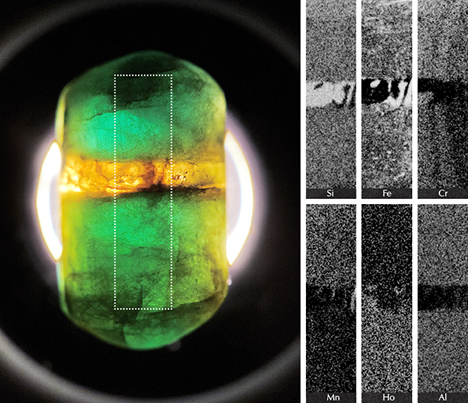Located about 60 miles east of San Diego, a new emerald deposit has been discovered in the Julian Mining District (figure 1). This area is known for pegmatite mines and hydrothermal mineral deposits; however, none of those are known to have produced emeralds to date. The emeralds (example shown in figure 2) were all collected by author RE and son Bruce Edley near the surface and are embedded in a biotite schist host rock. Most of the recovered single crystals have a translucent dark green color and inclusions, and they are typically smaller than 2 cm. A few light-colored green beryl crystals have been recovered from a nearby pegmatite. Their formation was likely correlated with metamorphic and hydrothermal processes associated with regional tectonism.

Samples were analyzed at the Natural History Museum of Los Angeles County and sent to GIA for species confirmation using laser ablation–inductively coupled plasma–mass spectroscopy (LA-ICP-MS). We performed Raman and X-ray fluorescence (XRF) hyperspectral mapping and powder X-ray diffraction (not shown) to determine mineralogy and elemental composition. Raman analysis on a polished pill-shaped gem (figure 3, left) identified beryl and quartz to confirm our observation of the rare combination of emerald and citrine. Raman further identified dolomite and hematite inclusions. XRF element maps (figure 3, right) show silicon (Si), chromium (Cr), magnesium (Mg), iron (Fe), aluminum (Al), and holmium (Ho) content. Of the approximately 425 carats of emeralds that have been recovered, about 5–10% contain macro-citrine inclusions, representing a unique aspect of this deposit.

The distribution of trace elements in the pill-shaped emerald indicates a complex series of events. The emerald is cross-cut by a layer of citrine. Half of the gem is enriched in trace holmium (below the citrine), where holmium is inversely correlated with manganese. Chromium-rich areas run perpendicular to the citrine, but align on either side of the citrine, suggesting that the emerald formed as a single crystal. The patterns of holmium and manganese hint toward secondary geochemical processes that may be related to later citrine emplacement, though the origin of these processes is unknown. The unusual mineral associations and elemental distribution demonstrate the geologic complexity of the deposit, and further work is needed to unravel its full history.
This article is republished with permission from the Gemological Institute of America (GIA).

